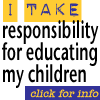
|
The Education Liberator, Vol. 1, No. 4, December 1995/January 1996 The KKK's attempt at thought control in Oregon schoolsThe great danger overshadowing all others?by Jackie Orsi Our children might all be in public school today were it not for an improbable conflict more than seventy years ago involving unlikely participants in unexpected roles: the Ku Klux Klan and the Society of the Sisters of the Holy Name of Jesus and Mary. It led to the Supreme Court decision Pierce v. Society of Sisters, which is the cornerstone of parental rights in America today. The parties and actions that led to the decision form one of the most astonishing of history lessons, one that demonstrates how the monolithic public school system could be turned into an ideological tool for any opportunistic group. It happened in Oregon in 1922. A state ballot initiative passed requiring all children ages 8 to 16 to attend public ? and only public ? schools. The King Kleagle of the KKK hailed the victory by offering these congratulatory words: "[The Ku Klux Klan] with its white-robed sentinels keeping eternal watch, shall for all time, with its blazing torches as signal fires, stand guard on the outer walls of the Temple of Liberty, cry out the warning when danger appears and take its place in the front rank of defenders of the public schools." Following a logic peculiar to itself, the KKK successfully channeled its hatred of diverse groups into a statewide effort to coerce all children into public schools. To be sure, the KKK thought, and still thinks, that anyone who isn't a child of Albion in color, ethnicity and creed is inherently inferior, but they came to see public schooling of all children as a good thing. It was a canny strategy. The close mixing of races and religions might be temporarily distasteful, but well worth the prize in the long run: control over children's minds. Their rhetoric pointed attention in another, more patriotic, direction; a Klansmen leader pronounced, "I believe that our Free Public School is the cornerstone of good government and that those who are seeking to destroy it are enemies of our Republic and are unworthy of citizenship." Be assured that public schools in Oregon were in no jeopardy of impending 'destruction' when the Klan set about to destroy private schools; only 7% of Oregon elementary school students even attended private schools. The only possible explanation of what happened in Oregon in 1922 is that the KKK tried to take advantage of the overwhelming majority position of "their kind of people" to choke out the tiny minority groups in their midst. Oregon had a minuscule black population of 0.3%. Catholics amounted to only 8% of the whole. And at the close of an era when Ellis Island was a turnstile to immigrants by the millions, only 13% of Oregon's citizens were foreign born. The Klan's signature was evident throughout the campaign, and they infiltrated other groups to promote their purposes. The Scottish Rite Masons, either as a front for the KKK or as a fellow in promulgating hate, took a leading role. A 1920 resolution of the Scottish Rite Masons declared,
Letters in the press more precisely reveal the paranoia at large in the populous. One man wrote, "young children in private schools have no defense against any private ideas antagonistic to our free institutions. We cannot afford to run this risk any longer, and we positively know that traitors are now at this deadly task." But it was not exactly private schools that the KKK and those who leagued with them took aim at; parochial schools were the main target: The initiative "is not a question of Catholics having the right to follow the teachings of their Dago pope, but the right of Protestants to educate their children by the best school system in the world", according to one letter. Another called children of Catholic schools "catechized monstrosities." Minorities in Oregon rose in opposition, of course. The historical record finds the voices of Jews, German Lutherans, Seventh-Day Adventists, Catholics, and blacks raised in protest, with echoing support from elements of the Presbyterian, Unitarian and Congregational churches. Educators outside of Oregon joined in. The president of Yale called it "thought control." Surprisingly, Oregon's public school teachers supported the bill. A reading of teacher's periodicals indicates that to some extent they may have missed the point and gone to a defensive posture because they imagined that a vote against the bill was a vote against public schools. There is also in their writings a palpable tone indicating that paranoia and bigotry had infected their ranks, too. On election day, the Oregon initiative to ban private schools passed, 115,506 to 103,685. Opponents did not delay in taking the matter to court, and Governor Pierce found himself having to defend his constituent's duly enacted law. His attorney argued, "the great danger overshadowing all others which confront the American people is the danger of class hatred...[we] don't know any better way to fortify the next generation against that insidious poison than to require that the poor and the rich, the people of all classes and distinction, and of all different religious beliefs, shall meet in the common schools, which are the great American melting pot, there to become...the typical American of the future. " The Supreme Court saw otherwise and rejected the Oregon law in a 9-0 vote. In Pierce v. Society of Sisters the Court gave us our firmest avowal of the fundamental rights of parents ? no small result. On the other hand, the Pierce decision treated a festering symptom without treating the cause. While it averted an immediate threat to freedom at that time, it did not eliminate a deep vulnerability that persists to our time. As long as America's children have no choice but to attend public schools, groups from the margin and groups in the mainstream will grapple for command of the Grand American Curriculum. It's not hard to identify a threat when it shows up in bed linens, illuminated by burning crosses and preaching overt racism. Now then, what if it appears dressed in fashions from JCPenneys, spotlighted by the kleig lights of TV, and touting the latest politically correct persuasions? Extreme or subtle, the threat is the same. Only one action will protect us: the separation of school and state. Jackie Orsi is a freelance writer in Moss Beach, California. She also serves as a Trustee for the California Homeschool Network. This article is copyrighted by the Alliance for the Separation of School & State. Permission is granted to freely distribute this article as long as this copyright notice is included in its entirety.
[top] |

